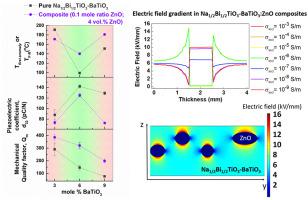Journal of Materiomics ( IF 9.4 ) Pub Date : 2021-06-27 , DOI: 10.1016/j.jmat.2021.06.008 Lalitha Kodumudi Venkataraman 1 , Till Frömling 1 , Jürgen Rödel 1

|
Na1/2Bi1/2TiO3-based materials exhibit potential for applications in high-power ultrasonics. The composites of Na1/2Bi1/2TiO3-yBaTiO3 (NBTyBT; y denotes mole%) with ZnO inclusions were demonstrated to stabilize a ferroelectric equilibrium that led to enhanced thermal depolarization temperature (Td) and increased mechanical quality factor (Qm). This work addresses the influence of the matrix NBTyBT phase by investigating two limiting choices based on symmetry (tetragonal/rhombohedral) and polar (relaxor/ferroelectric) nature. While the composites constituting the tetragonal NBT9BT (non-ergodic relaxor at room temperature) matrix phase exhibit improved Td, the critical temperatures in the composites with rhombohedral NBT3BT (displaying spontaneous ferroelectric order at room temperature) exhibit only marginal changes. Further, NBT3BT composites feature a 45% increase in Qm, while the corresponding increase is roughly three-fold for the NBT9BT composites. A 3-D Finite Element Method is used to simulate the electric field gradient at the matrix/inclusion interface, with the effective field distribution estimated to be higher than the applied field for highly conducting ZnO inclusions. The electrical properties indicate that, while the deviatoric stress at the matrix/inclusion interface stabilizes the ferroelectric equilibrium for the relaxor matrix phase, the stresses disrupt the long-range order for the ferroelectric matrix phase. These results establish the volume-limit of the second phase to stabilize a ferroelectric equilibrium, in addition to substantiating the role of residual stress evidenced by changes in the polar nature. Finally, a comparison of the composites with different NBTyBT phases is presented, with NBT6BT:ZnO composites demonstrating an optimal increase in both Td and Qm.
中文翻译:

基体相和电场梯度在 Na1/2Bi1/2TiO3BaTiO3:ZnO 复合材料中的作用
Na 1/2 Bi 1/2 TiO 3基材料显示出在高功率超声应用中的潜力。Na 1/2 Bi 1/2 TiO 3 - y BaTiO 3 (NBT y BT; y表示摩尔%) 与 ZnO 夹杂物的复合材料被证明可以稳定铁电平衡,从而提高热去极化温度 (T d ) 并增加机械品质因数 (Q m )。这项工作解决了矩阵 NBT y的影响通过研究基于对称性(四方/菱面体)和极性(弛豫/铁电)性质的两种限制选择来实现 BT 相。虽然构成四方 NBT9BT(室温下非遍历弛豫)基体相的复合材料表现出改善的 Td,但具有菱面体NBT3BT(在室温下表现出自发铁电有序)的复合材料中的临界温度仅表现出边缘变化。此外,NBT3BT 复合材料的 Q m增加了 45%,而 NBT9BT 复合材料的相应增加大约是三倍。3-D 有限元方法用于模拟基体/夹杂物界面处的电场梯度,估计有效场分布高于高导电 ZnO 夹杂物的施加场。电学特性表明,虽然基体/夹杂物界面处的偏应力稳定了弛豫基体相的铁电平衡,但应力破坏了铁电基体相的长程有序。这些结果确立了第二相的体积限制,以稳定铁电平衡,此外还证实了极性变化所证明的残余应力的作用。最后,比较了不同 NBT y的复合材料呈现了 BT 相,其中 NBT6BT:ZnO 复合材料表现出 T d和 Q m的最佳增加。


























 京公网安备 11010802027423号
京公网安备 11010802027423号